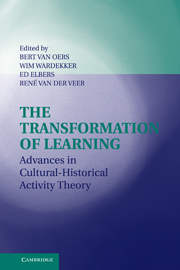Book contents
- Frontmatter
- Contents
- List of Contributors
- Preface
- INTRODUCTION
- SECTION ONE TENETS OF ACTIVITY THEORY
- SECTION TWO IDENTITY, DIVERSITY, AND INCLUSION
- Introduction to Section Two: Identity, Diversity, and Inclusion
- 9 Identity Shifts in Informal Learning Trajectories
- 10 No Human Being Is Illegal: Counteridentities in a Community of Undocumented Mexican Immigrants and Children
- 11 Cultural Identity and Emigration: A Study of the Construction of Discourse about Identity from Historical-Cultural Psychology
- 12 Diversity in the Construction of Modes of Collaboration in Multiethnic Classrooms: Continuity and Discontinuity of Cultural Scripts
- 13 “Discourse” in Cultural-Historical Perspective: Critical Discourse Analysis, CHAT, and the Study of Social Change
- 14 Reason and Dialogue in Education
- SECTION THREE DYNAMICS OF ACTIVITY AND THE VARIATIONS OF LEARNING
- Index
- References
12 - Diversity in the Construction of Modes of Collaboration in Multiethnic Classrooms: Continuity and Discontinuity of Cultural Scripts
Published online by Cambridge University Press: 25 August 2009
- Frontmatter
- Contents
- List of Contributors
- Preface
- INTRODUCTION
- SECTION ONE TENETS OF ACTIVITY THEORY
- SECTION TWO IDENTITY, DIVERSITY, AND INCLUSION
- Introduction to Section Two: Identity, Diversity, and Inclusion
- 9 Identity Shifts in Informal Learning Trajectories
- 10 No Human Being Is Illegal: Counteridentities in a Community of Undocumented Mexican Immigrants and Children
- 11 Cultural Identity and Emigration: A Study of the Construction of Discourse about Identity from Historical-Cultural Psychology
- 12 Diversity in the Construction of Modes of Collaboration in Multiethnic Classrooms: Continuity and Discontinuity of Cultural Scripts
- 13 “Discourse” in Cultural-Historical Perspective: Critical Discourse Analysis, CHAT, and the Study of Social Change
- 14 Reason and Dialogue in Education
- SECTION THREE DYNAMICS OF ACTIVITY AND THE VARIATIONS OF LEARNING
- Index
- References
Summary
If students from different ethnic groups or cultural backgrounds join together in one classroom and construct a “common” practice, can they still be described as different? Given this “common” classroom practice that they share (which is the result of both classroom traditions of the past and the day-by-day sharing of experiences leading to a common history and tradition as a group), and the reshuffling of the variety brought along given the particular dynamics of this classroom, how is this difference to be perceived or conceptualized?
Furthermore, if we are able to describe this variety, how do we describe it in terms of its effect for the construction of knowledge or learning? Do we see variety as a problem or as fruitful input? For instance, do we see this as productive or counterproductive? (Compare the classic discontinuity thesis in which diversity is seen as disadvantageous for the culturally “deviant” groups versus seeing heterogeneity in the classroom, by using the Bakhtinian term social heteroglossia, as a potential that is able to foster learning – e.g., Gutierrez, Rymes, & Larson, 1995, pp. 447, 453.)
In this chapter we consider different conceptualizations of (cultural) variety in classrooms from a sociocultural activity theory perspective and related approaches, especially those concepts that answer the question how this variety is related to the differential participation of students in past or present out-of-school contexts.
- Type
- Chapter
- Information
- The Transformation of LearningAdvances in Cultural-Historical Activity Theory, pp. 219 - 241Publisher: Cambridge University PressPrint publication year: 2008
References
- 2
- Cited by



